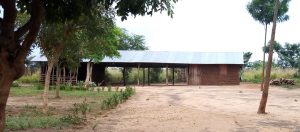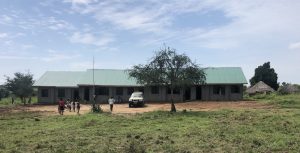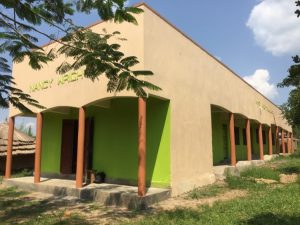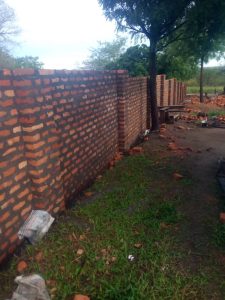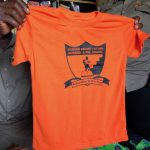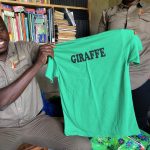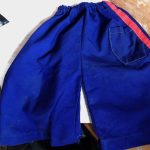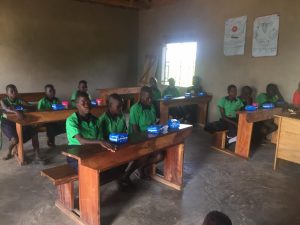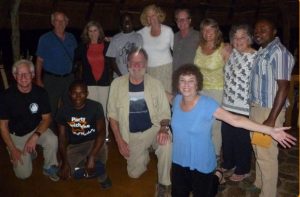Bright Future Nursery and Primary School
The cost to sponsor a child for a year is $65 USD. Currently, 114 of our 205 students are sponsored. This enable a child to:
-
-
-
-
-
- Pay class fees
- Receive a school uniform
- Receive school supplies
- Receive sanitary supplies
- Have a lunch each school day
-
-
-
-
The school aims to improve children’s well-being in the Albert region, especially those who can’t afford to safely go to school. There are many reasons for these problems. The nearest government school is far away, and it is not safe for the kids to walk to it because Baboons attack the kids on their way to and from the school. There are no funds to transport the kids safely through the Baboon area. There are also African cultural biases where girls have to remain home to work in the kitchen, and boys have to look after the goats, cows, and sheep at home. Due to the long walk to the nearest school, few children in the village could attend school.
In 2013 the community formed the Mubaku Community Conservation Organization (MUCCO), a not-for-profit Community-Based Organization (CBO). The community determines what the cost per student would be to each parent. In 2014, enough parents signed up to hire the first teacher and MUCCO was able to start the school. The first classes were held under a tree. Initially, they had to stop enrollment at 73 Children as the school only had one teacher. In 2015 the school added two more teachers and built a mud and stick shade structure. Attendance was 135 kids in 2018, and by the fall of 2019, with the completion of the first building was 205. For May 2020, attendance was 215 kids.
The village elders (a group of men and women) also decided that their school would accept any child regardless of which church their family attended or didn’t attend. Many schools in Uganda require the families to attend a particular church The people of Mubaku attend Catholic, Presbyterian, and Charismatic churches or no church at all. The village sees its mission as educating all the children of Mubaku
The school has come a long way!
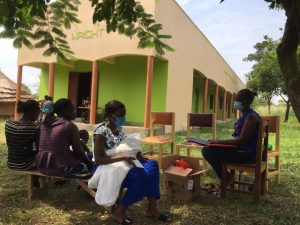
July 23, 2021: Second Building. Three Nursery classrooms and the Women’s Empowerment Center. Women are attending a health clinic for their babies.
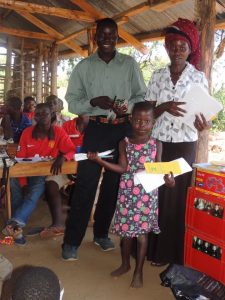 Bright Future Nursery School is three years of schooling that covers the ages of three to six. It corresponds to the USA preschool and kindergarten.
Bright Future Nursery School is three years of schooling that covers the ages of three to six. It corresponds to the USA preschool and kindergarten.
Bright Future Primary School is seven years of education starting at age six. These levels are referred to as Primary One to Primary Seven. With normal annual progression, the children are thirteen when they graduate, but often students have to drop out for a while, so it is not unusual to find teenagers sitting in the classroom. At the end of Primary Seven, students take their first major national exam called the Primary Leaving Examinations (PLE). PLEs have four subjects English Language, Mathematics, Science, and Social Studies.
The children have a PE day each week where they play games and form teams to compete. The students wear different colored shirts with their team’s animal on the back.
Girls Hygiene Classes
An important part of the school is holding classes for the older girls to teach about hygiene and to pass out supplies.
Education in Uganda
For more on the levels of education in Uganda, go to https://www.theguardian.com/katine/2010/feb/08/education-system-explainer
In 2018 Mubaku Educational Foundation (MEF) was formed to raise funds for the school from donors in North America and Europe.
Our Facilities
In 2014 the Mama Africa group purchased the land, which enabled MUCCO to build the shade structure. The shade structure allows them to keep on teaching when the weather turns wet. But it does not block the noise from one classroom to another.
The four primary classrooms building (Completed 2019)
The initial goal was to build a four-room schoolhouse with blackboards and desks for the students. MUCCO decided to build the school as they received the funds.
In 2016, a tourist helped MUCCO buy six acres to build a permanent structure and fields for the school. The land is about 600 meters from the original location. Later in 2016, another tourist gave MUCCO enough money to create plans for the school and then build the foundations. MUCCO projected it would take anywhere from five to ten years to raise funds to build the first permanent building.
In October 2018, Mubaku Educational Foundation (MEF) began raising funds to complete the structure. MUCCO used local labor and materials to help the Village of Mubaku as a side benefit. The four-classroom building was completed in August 2018. On September 8, 2019, the new building was dedicated.
Click here to view all the photos of the construction progress for the first building.
The three nursery classrooms and Women’s Empowerment Center building (Finished July 2021)
The next goal of the school was to build three nursery-age classrooms and a Women’s Empowerment Center. In the Women’s Empowerment Center, women from the village will be able to make and sell crafts to help support the school and their families and learn to read and write while their children attend Nursery School.
This building was named in honor of Nancy Wright, a long-time school supporter. Nancy passed away shortly after attending the Primary School Classroom Building’s dedication on September 8, 2019. The people of Mubaku village requested the new building be named in her honor. Read more about Nancy’s contribution to Mubaku in our November 2019 Mubaku Educational Foundation Newsletter #2.
Click here to view all construction progress photos for the Nancy Wright building.
Four Primary Classrooms and Libary. Currently under construction.
The village has decided that an additional classroom building is their next greatest need. The reason the villagers give for this decision is that this will give each grade level its own classroom and it would provide a library for the schools growing collection of books.
Building a classroom building, however, doesn’t happen overnight. MEF worked with MUCCO to finalize the construction and operations budget. The construction is estimated at $21,000 USD and is expected to complete in late 2024.
Read about the construction process for the Third Classroom Building
Contribute to the building of this facility
Some of the Costs of Running Bright Future Nursery and Primary School
Books range from 15,000 Ugandan Shillings (UGX), roughly $4 USD to 35,000 UGX, roughly $10 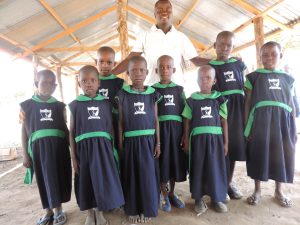 USD per book.
USD per book.
A roll of fabric to make uniforms goes for 380,000 UGX, roughly $100 USD. A roll makes s42 dresses + 22 pairs of boy’s pants. However, since the village did not own any sewing machines, the sewing was done elsewhere. With the completion of the Women’s Empowerment Center, foot-powered sewing machines ($208Each) were purchased as part of setting up the Women’s Empowerment Center. Now local women are paid to make the uniforms.
We feed every child every day. To feed 115 children, it takes 6 kg (13 1/3 lbs) of maize (corn) flour. That costs about 18,000 UGX , roughly $5 USD per day.
2024 School Schedule
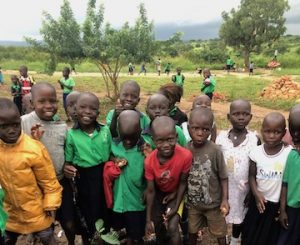 The Ministry of Education and Sports has set the school schedule for 2024 as follows:
The Ministry of Education and Sports has set the school schedule for 2024 as follows:
| Start | End | |
| Term one | 5th Feb. 2024 | 3rd May 2024 |
| Term Two. | 27th May 2024 | 23th Aug 2024 |
| Term Three | 16th Sept 2024 | 6th, Dec 2024 |
Our Enrollment
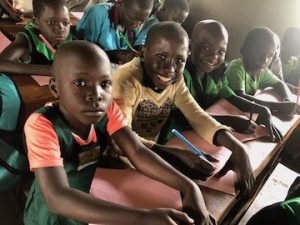 Our enrollment peaked at 206 students in January 2020. We currently have 190 Students, and 20 students are on the waiting list for sponsors.
Our enrollment peaked at 206 students in January 2020. We currently have 190 Students, and 20 students are on the waiting list for sponsors.

